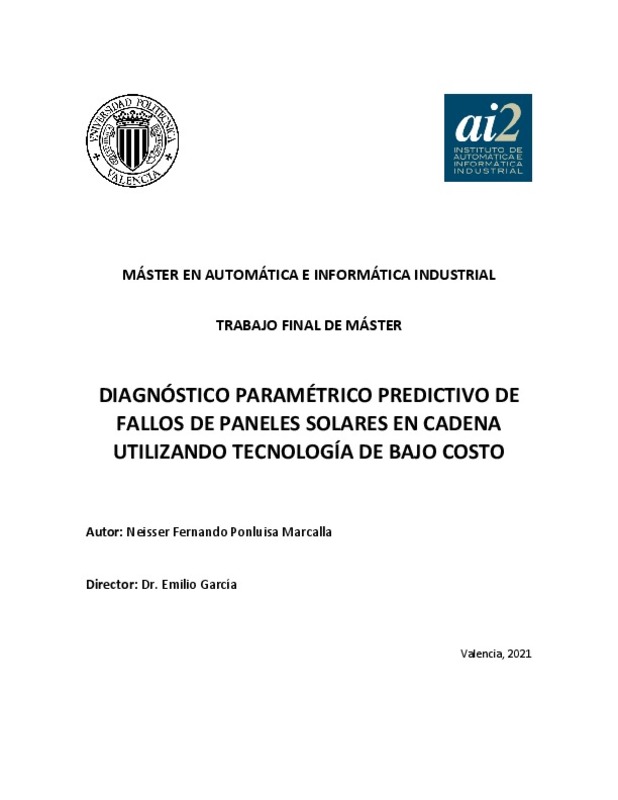|
Resumen:
|
[ES] La creciente demanda de energía eléctrica en la sociedad, ha provocado la necesidad de buscar nuevas formas para producir energía eléctrica y que a su vez sea amigable con el medio ambiente, por ello cada día se ...[+]
[ES] La creciente demanda de energía eléctrica en la sociedad, ha provocado la necesidad de buscar nuevas formas para producir energía eléctrica y que a su vez sea amigable con el medio ambiente, por ello cada día se realizan investigaciones como es el caso de este trabajo, enfocado en los paneles solares. La instalación de los paneles solares en la actualidad crece de una manera exponencial y al ser instalados en la intemperie, están expuestos a diferentes tipos de degradación que causan fallos que afectan el óptimo desempeño en la producción de energía, por lo que es de gran importancia aplicar técnicas avanzadas de diagnóstico predictivo de fallos durante la su operación, para que garanticen su viabilidad económica.
El objetivo principal de este trabajo es proponer un método para la supervisión y diagnostico predictivo de fallo en una cadena de paneles solares en tiempo real utilizando tecnología de bajo costo. La detección de fallo se enfoca en el análisis de las curvas Voc-Isc, por otro lado, se hace énfasis en el uso de tecnología de bajo costo como son: el módulo ESP8266, sensor ACS712-5A, sensor FZ0430 y módulos de relés.
La arquitectura del método a seguir para su desarrollo es adquirir los datos de los sensores a través del módulo ESP8266 que envía a internet usando el protocolo Modbus TCP/IP hasta un computador en donde está instalado el sistema SCADA iFIX y KepServerEX; El software KepServerEX recibe los datos del módulo ESP8266 y transmite por un túnel de comunicación OPC hasta el SCADA (iFIX). En el SCADA se realizan diferentes experimentos, que se basa en cubrir diferentes áreas de un SP, con la finalidad de observar las variaciones en las curvas Voc-Isc para evidenciar si el método propuesto logra el diagnóstico predictivo de fallos en tiempo real, además, facilita la desconexión automática del panel solar con fallo.
Finalmente se comprobó que el método propuesto cumple el objetivo, siendo una solución sencilla, confiable, eficiente y fácil de implementar para el diagnóstico predictivo de fallos, además, se necesita muy bajo presupuesto y es aplicable a instalaciones fotovoltaicas de gran tamaño.
[-]
[EN] The growing demand for electrical energy in society has led to the need to seek new ways to produce electrical energy and that in turn be friendly to the environment, for this reason, research is carried out every ...[+]
[EN] The growing demand for electrical energy in society has led to the need to seek new ways to produce electrical energy and that in turn be friendly to the environment, for this reason, research is carried out every day, as is the case in this work, focused on on the solar panels. The installation of solar panels at present grows exponentially and when installed outdoors, they are exposed to different types of degradation that cause failures that affect the optimal performance in energy production, so it is of great importance. apply advanced predictive failure diagnosis techniques during their operation, to ensure their economic viability.
The main objective of this work is to propose a method for the monitoring and predictive diagnosis of failure in a chain of solar panels in real time using low-cost technology. Failure detection focuses on the analysis of the Voc-Isc curves, on the other hand, emphasis is placed on the use of low-cost technology such as: the ESP8266 module, ACS712-5A sensor, FZ0430 sensor and relay modules.
The architecture of the method to be followed for its development is to acquire the data from the sensors through the ESP8266 module that sends to the internet using the Modbus TCP / IP protocol to a computer where the SCADA iFIX and KepServerEX system is installed; The KepServerEX software receives the data from the ESP8266 module and transmits it through an OPC communication tunnel to the SCADA (iFIX). In SCADA, different experiments are carried out, which are based on covering different areas of a SP, in order to observe the variations in the Voc-Isc curves to show if the proposed method achieves the predictive diagnosis of failures in real time, in addition, facilitates automatic disconnection of the failed solar panel.
Finally, it was verified that the proposed method meets the objective, being a simple, reliable, efficient and easy-to-implement solution for predictive failure diagnosis, in addition, it requires a very low budget and is applicable to large photovoltaic installations.
[-]
|







